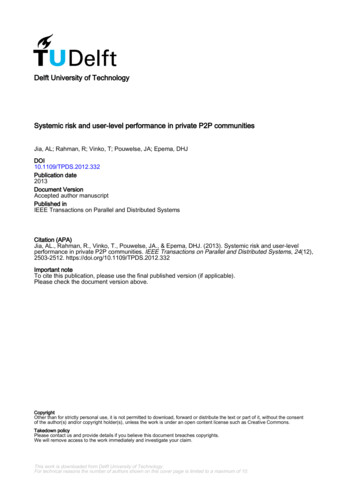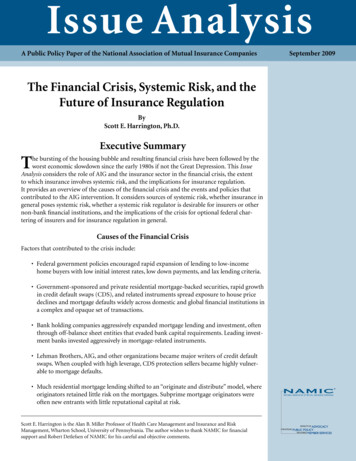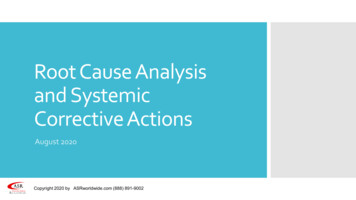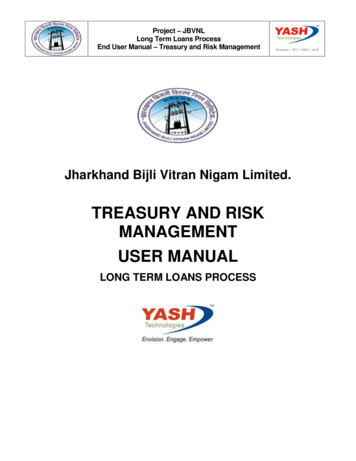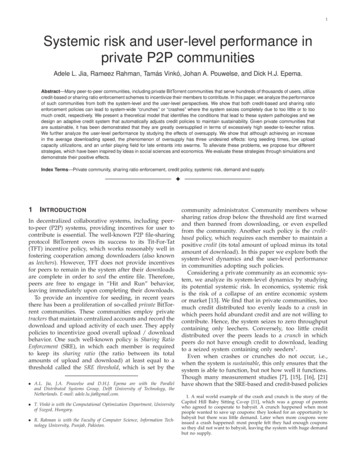
Transcription
1Systemic risk and user-level performance inprivate P2P communitiesAdele L. Jia, Rameez Rahman, Tamás Vinkó, Johan A. Pouwelse, and Dick H.J. Epema.Abstract—Many peer-to-peer communities, including private BitTorrent communities that serve hundreds of thousands of users, utilizecredit-based or sharing ratio enforcement schemes to incentivize their members to contribute. In this paper, we analyze the performanceof such communities from both the system-level and the user-level perspectives. We show that both credit-based and sharing ratioenforcement policies can lead to system-wide “crunches” or “crashes” where the system seizes completely due to too little or to toomuch credit, respectively. We present a theoretical model that identifies the conditions that lead to these system pathologies and wedesign an adaptive credit system that automatically adjusts credit policies to maintain sustainability. Given private communities thatare sustainable, it has been demonstrated that they are greatly oversupplied in terms of excessively high seeder-to-leecher ratios.We further analyze the user-level performance by studying the effects of oversupply. We show that although achieving an increasein the average downloading speed, the phenomenon of oversupply has three undesired effects: long seeding times, low uploadcapacity utilizations, and an unfair playing field for late entrants into swarms. To alleviate these problems, we propose four differentstrategies, which have been inspired by ideas in social sciences and economics. We evaluate these strategies through simulations anddemonstrate their positive effects.Index Terms—Private community, sharing ratio enforcement, credit policy, systemic risk, demand and supply. 1I NTRODUCTIONIn decentralized collaborative systems, including peerto-peer (P2P) systems, providing incentives for user tocontribute is essential. The well-known P2P file-sharingprotocol BitTorrent owes its success to its Tit-For-Tat(TFT) incentive policy, which works reasonably well infostering cooperation among downloaders (also knownas leechers). However, TFT does not provide incentivesfor peers to remain in the system after their downloadsare complete in order to seed the entire file. Therefore,peers are free to engage in “Hit and Run” behavior,leaving immediately upon completing their downloads.To provide an incentive for seeding, in recent yearsthere has been a proliferation of so-called private BitTorrent communities. These communities employ privatetrackers that maintain centralized accounts and record thedownload and upload activity of each user. They applypolicies to incentivize good overall upload / downloadbehavior. One such well-known policy is Sharing RatioEnforcement (SRE), in which each member is requiredto keep its sharing ratio (the ratio between its totalamounts of upload and download) at least equal to athreshold called the SRE threshold, which is set by the A.L. Jia, J.A. Pouwelse and D.H.J. Epema are with the Paralleland Distributed Systems Group, Delft University of Technology, theNetherlands. E-mail: adele.lu.jia@gmail.com. T. Vinkó is with the Computational Optimization Department, Universityof Szeged, Hungary. R. Rahman is with the Faculty of Computer Science, Information Technology University, Punjab, Pakistan.community administrator. Community members whosesharing ratios drop below the threshold are first warnedand then banned from downloading, or even expelledfrom the community. Another such policy is the creditbased policy, which requires each member to maintain apositive credit (its total amount of upload minus its totalamount of download). In this paper we explore both thesystem-level dynamics and the user-level performancein communities adopting such policies.Considering a private community as an economic system, we analyze its system-level dynamics by studyingits potential systemic risk. In economics, systemic riskis the risk of a collapse of an entire economic systemor market [13]. We find that in private communities, toomuch credit distributed too evenly leads to a crash inwhich peers hold abundant credit and are not willing tocontribute. Hence, the system seizes to zero throughputcontaining only leechers. Conversely, too little creditdistributed over the peers leads to a crunch in whichpeers do not have enough credit to download, leadingto a seized system containing only seeders1 .Even when crashes or crunches do not occur, i.e.,when the system is sustainable, this only ensures that thesystem is able to function, but not how well it functions.Though many measurement studies [7], [15], [16], [21]have shown that the SRE-based and credit-based policies1. A real world example of the crash and crunch is the story of theCapitol Hill Baby Sitting Co-op [11], which was a group of parentswho agreed to cooperate to babysit. A crunch happened when mostpeople wanted to save up coupons: they looked for an opportunity tobabysit but there was little demand. Later when more coupons wereissued a crash happened: most people felt they had enough couponsso they did not want to babysit, leaving the system with huge demandbut no supply.
110.80.80.60.60.6CDF10.8CDFCDF20.40.40.40.20.20.20 1100101Sharing ratio10200255075 100 125 150 175 200The number of seeders in swarms with no leechers00255075 100 125 150Seeder to leecher ratio17520010Fig. 1. The CDF of the sharing ratios in CHDBits.org.(a) The CDF of the number of (b) The CDF of the seeder-toseeders in swarms with no leech- leecher ratio in swarms with atersleast one leecherFig. 2. Oversupply in CHDBits swarms.2R EALWORLD OBSERVATIONSTo support our later analysis, we first present real worldobservations of two private communities, CHDBits.org[2] and Bitsoup.org [3]. CHDBits and Bitsoup both require the users to maintain sharing ratios larger thanthe threshold of 0.7. The trackers of CHDBits collect information that is periodically reported by the BitTorrentclients of its users, which is displayed in the form ofHTML pages available to only its users. We crawledthese trackers in May 2011. For each user in CHDBits,we collected the information on its user profile pageincluding the upload and download amount, the seedingtime, and the sharing ratio. For each torrent, we collectedthe information of its published date, and its numbers10.80.6CDFare very effective in boosting contribution levels in termsof high seeder-to-leecher ratios and the correspondinghigh downloading speeds, we argue that the abundantsupply of bandwidth also has several negative effectssuch as excessively long seeding times that are oftenunproductive. To explore this, we analyze the user-levelperformance in sustainable private communities.The main contributions of this paper are:1. We demonstrate that in private communities creditcrashes and crunches can occur and we identify conditions that lead to these extreme outcomes (Section 4);2. We present a theoretical model that predicts whethera system will crash, crunch, or be sustainable over adefined time horizon. Based on this model we proposean adaptive credit policy that helps the system to avoidcrashes and crunches (Section 5);3. We show that users in sustainable private communities achieve high downloading speeds but are forcedto seed for excessively long times, during which theirupload capacity utilizations are quite low (Section 6).Further, when the popularity of a swarm decreases overtime, peers that join the swarm not early enough willhave to seed much longer than peers who join (strategically) at the beginning of the swarm (Section 8);4. We propose and evaluate four new strategies thatalleviate these problems while still maintaining a reasonable system-wide downloading speed (Sections 7 and 8).We use private BitTorrent communities as an example,but our analysis is applicable to any system that adoptscontribution enforcement policies, by generalizing themetrics for determining the credit and the sharing ratiofrom the upload and download amounts to any metricsrepresenting contribution and consumption.0.40.20.0010.010.11Idle seeding time/total seeding timeFig. 3. The CDF of the fraction of idle seeding time ofpeers with sharing ratios smaller than 1 in BitSoup.org.of seeders and leechers at the time of snapshot. In total,information on all the 31,547 registered users and 40,040torrents was obtained. For Bitsoup, we use the tracespublished in [5] that report the user activity of 84,007users in 13,741 torrents during a period of two months.2.1 The existence of over-seeding behaviorIn CHDBits, maintaining a sharing ratio slightly abovethe SRE threshold is sufficient for a user to start downloading a new file. However, we observe that not all theusers behave like this. As shown in Fig. 1, more than 95%of the users in CHDBits keep sharing ratios higher than0.7 and more than 50% of the users keep them higherthan 2. This phenomenon of peers seeding more thanrequired and achieving sharing ratios that are (much)higher than the SRE threshold has also been observed inmany other communities [15].From the above observation we abstract two userbehaviors for our later analysis, lazy-seeding and overseeding. Lazy-seeding peers seed the minimum amountrequired by the enforcement policies. They represent theusers who are download-oriented, i.e., who only seedenough to maintain adequate sharing ratios or credit tobe able to start new downloads. On the other hand, overseeding peers are deposit-oriented, and always maintainsharing ratios (much) higher than required. The behaviorof such peers may be triggered by various motivationssuch as altruism, a desire to be part of the rich eliteof the community, or a habit of storing credit for thefuture. In line with the terminology used in economics,over-seeding peers can be understood as hoarders as theirbehavior essentially amounts to hoarding credit.2.2 The oversupplyThe main motivation for implementing credit or SREpolicies is to close the gap between bandwidth demand
3and supply as observed in public BitTorrent communities, where there is significantly more demand thansupply [16]. However, the presence of over-seeding peerscompletely reverses the situation and in private communities, swarms tend to be extremely oversupplied.At the time of the crawling, CHDBits had 33,041 activeswarms (with at least one leecher or one seeder), amongwhich 26,402 swarms (79.9%) had no leechers at all! Asshown in Fig. 2(a), 40% of the swarms with no leechersstill had at least 5 seeders, and for swarms with at least1 leecher, the seeder-to-leecher ratio (SLR) is quite high:as shown in Fig. 2(b), 50% (5%) of these swarms had anSLR of at least 6 (30). We see clearly that a majority ofthe swarms are heavily oversupplied. Therefore, in suchswarms, intuitively it is difficult for seeders to performany actual uploads. We validate our speculation throughthe following observation.2.3 Unproductive seedingIt is clear that in order to achieve high sharing ratios,peers need to spend considerable amount of seedingtime. In the case of over-seeding peers, long seedingtimes are to be expected. However, we observe thateven many peers with small sharing ratios suffer fromexcessively long seeding times, and a significant part oftheir seeding time is spent idle without being able toupload anything to others. As a consequence, they haveto wait for a long period until their sharing ratios arehigh enough to start new downloads.Fig. 3 shows the CDF of the fraction of idle seedingtime of peers with sharing ratios smaller than 1 in BitSoup. We see that 10% of these peers spend at least halfof their seeding time idle. Note that Fig. 3 only shows thefraction of idle seeding time. It can be conjectured thatthe fraction of seeding time that is not completely idleyet still yields very low upload speed, would be muchhigher. We term this situation as unproductive seeding andwe hypothesize that it is due to the oversupply undercredit-based or SRE-based schemes.3M ODELDESCRIPTIONIn this section we explain the credit-based and SREbased incentive policies, and our model of communitiesthat employ one of these policies.3.1 Credit-based versus SRE-based policiesCredit-based and SRE-based policies are essentially verysimilar, in a way that they can be understood as variations of each other. The idea behind both policies is thatevery peer has to maintain a certain relation betweenthe total amount u(t) it has uploaded and the totalamount d(t) it has downloaded since it entered thecommunity until time t. The credit-based policy requiresusers to keep non-negative credit, i.e., to ensure thatu(t) d(t) 0, while the SRE-based policy requires usersto keep a minimum sharing ratio SR(t) u(t)/d(t), i.e.,to ensure that SR(t) α, where α is the SRE threshold.Throughout this paper we assume α 1, as most privatecommunities do [3], [1]. When α 1 in the SRE policy,the SRE-based and credit-based policies coincide.By enforcing non-negative credit in the credit-basedpolicy, the exchanging of data by peers does not generate new credit, and the total amount of credit in thecommunity is always equal to zero (or to the sum of theinitial credits allocated to the peers by the communityadministrator). In contrast, an SRE-based policy allowsusers to have negative credit (i.e., to have u(t) d(t) 0,which means that SR(t) 1). Holding negative creditincreases the amount of credit among the peers withpositive credit in the system—in other words, by holdingnegative credit a user is essentially minting credit. Moreprecisely, the total credit minted by a user in an SREbased community with SR(t) 1 until time t is:d(t) u(t) (1 SR(t))d(t),(1)which is bounded by (1 α)d(t). As the sharingratios of peers fluctuate, SRE-based communities holda dynamic amount of credit circulating in the system.3.2 The basic modelWe consider a community that is either credit-basedor SRE-based. The community comprises a set of sswarms2 each associated with a file of size F (expressedin number of pieces or un
Netherlands. E-mail: adele.lu.jia@gmail.com. . 0 25 50 75 100 125150 175 200 0 0.2 0.4 0.6 0.8 1 The number of seeders in swarms with no leechers CDF (a) The CDF of the number of seeders in swarms with no leech-ers 0 25 50 75 100 150 175 200 0.8 1 Seeder to leecher ratio (b) The CDF of the seeder-to-leecher ratio in swarms with at least one leecher Fig. 2. Oversupply in CHDBits swarms. 0 .
